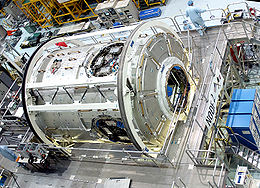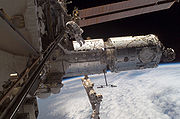- Node 2
-
Navigation Internationale Raumstation 
PMA-2 
Oben/Unten 
Kibō (MPLM) / (HTV) Columbus 
Destiny Harmony (englisch für Harmonie) ist nach Unity das zweite Verbindungsmodul (früher Node 2 genannt) der Internationalen Raumstation (ISS). Es verfügt über acht Racks, die zur Versorgung der Station mit Luft, Elektrizität und Wasser dienen, sowie andere lebensnotwendige Systeme enthalten.
Harmony ist 6,71 m lang, hat einen Durchmesser von 4,48 m und eine Startmasse von 14,5 t. Später folgt mit Tranquility noch ein dritter und letzter Verbindungsknoten.
Harmony kontrolliert und verteilt die Ressourcen der Trägerstruktur und des US-Labors Destiny zu den verbundenen Segmenten; dem europäischen Columbus-Labor, dem Centrifuge Accommodations Module (nach jüngsten Planungen gestrichen), dem japanischen Wissenschaftsmodul Kibō, dem Mehrzweck-Logistikmodul und dem HTV-Transportfahrzeug. Zudem dient es als Ausgangspunkt für das ISS Remote Manipulator System.
Das Modul gehört zum US-amerikanischen Teil der Station und wurde von Alenia Spazio (Italien) im Auftrag der Europäischen Weltraumorganisation (ESA) und der Agenzia Spaziale Italiana für die NASA gebaut. Diese transportiert dafür im Gegenzug das Raumlabor Columbus zur ISS.
Harmony wurde mit einem Airbus Beluga vom italienischen Turin in die USA geflogen und traf am 1. Juni 2003 am Kennedy Space Center ein. Am 18. Juni erfolgte die offizielle Übergabe an die NASA. Das Modul startete am 23. Oktober 2007 mit der Space-Shuttle-Mission STS-120 zur ISS und wurde drei Tage später vorläufig an Unity montiert. Am 14. November 2007 wurde es an seine endgültige Position, am Ende des Destiny Labors, verlagert.
Weblinks
- ESA: Daten zu Harmony (englisch)
- NASA Feature: Harmony Node 2 (englisch)
- NASA: Space Station Module In Perfect ‘Harmony’ With New Name, 14. März 2007 (englisch)
Module der Internationalen RaumstationSarja · Unity · PMA · Swesda · Integrated Truss Structure · Destiny · ESP · Mobile Servicing System · Canadarm2 · Quest · Pirs · Harmony · Columbus · Kibō (ELM-PS + PM) · Canada Hand
Noch zu startende Module: Kibō (EF) · MLM · ERA · Tranquility · Cupola · DCM · MRM-2 · ELC
Gestrichene Module: CAM · Habitation Module · ICM · IPM · Research Modules · SPP · UDM · DSM · MPM Enterprise · Crew Return Vehicle
Wikimedia Foundation.



